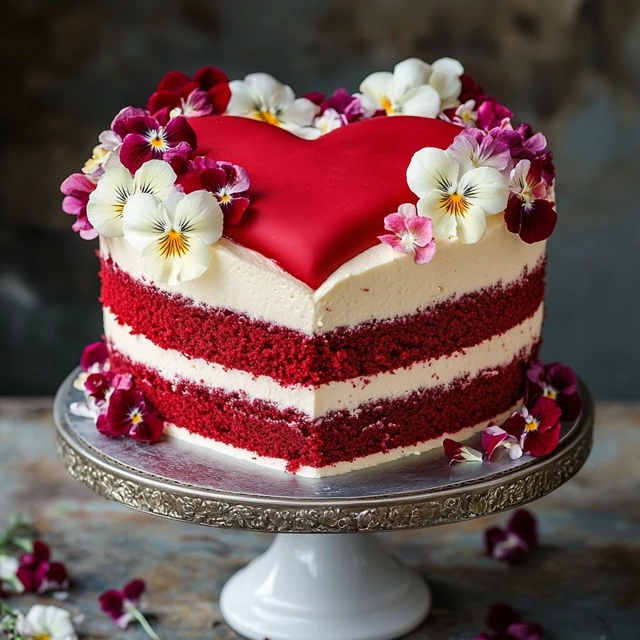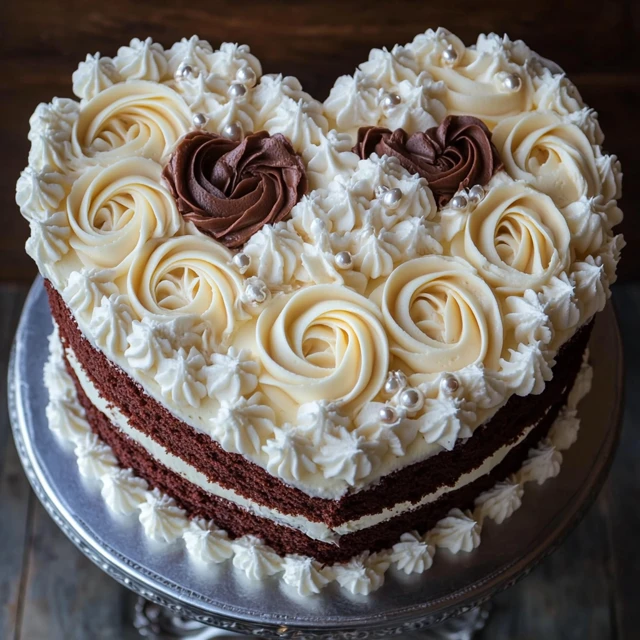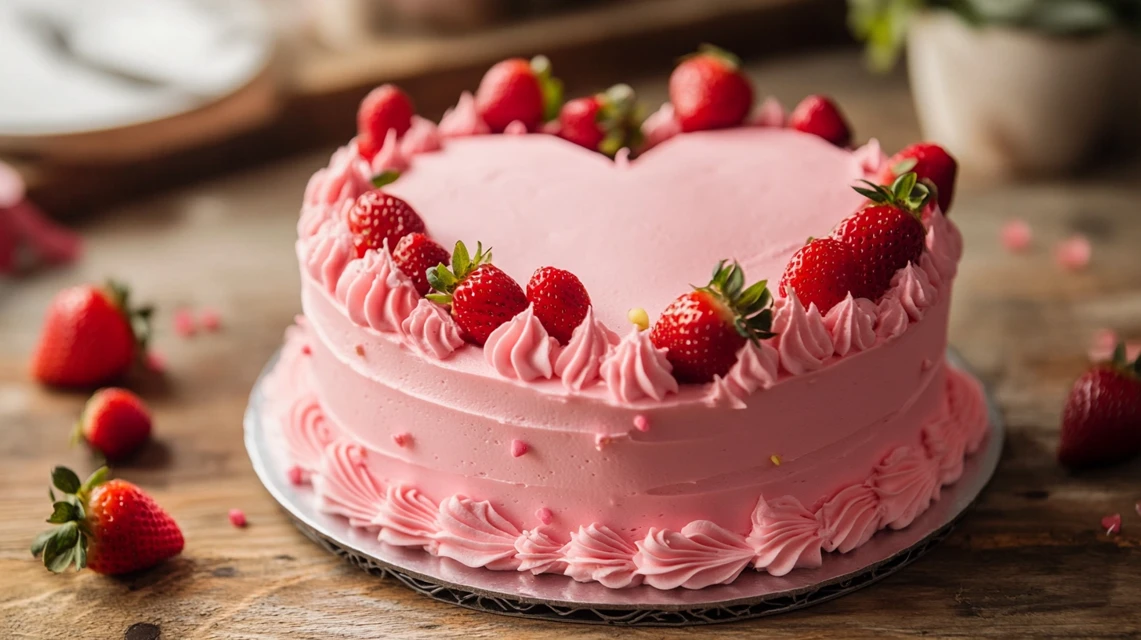Understanding Layers in Heart Cakes
The number of layers in a heart cake significantly impacts its appearance, flavor, and suitability for different occasions. Layers not only add height but also provide opportunities for creative fillings and decorations. Whether you’re planning an intimate celebration or a grand event, choosing the right number of layers is essential to making your cake both functional and visually appealing.
Importance of Layers in Cake Design
Layers are more than just structural elements; they define the cake’s overall presentation and flavor profile. A multi-layer cake offers more room for fillings like buttercream, jam, or ganache, creating a richer and more indulgent dessert. Additionally, layers add height, making the cake stand out as a centerpiece for any event.
From a design perspective, layers allow for intricate frosting techniques and decorations. For example, a heart cake with multiple layers can feature gradient colors, textured frosting, or elegant piping, making it more visually striking. Layers also make it easier to customize the cake for specific themes or occasions.
Single-Layer Heart Cake
A single-layer heart cake is simple yet charming, perfect for small gatherings or casual celebrations. Its flat surface provides a clean canvas for basic decorations, such as smooth frosting, sprinkles, or a heartfelt message written with a piping bag.
When to Choose a Single-Layer Cake:
- For intimate gatherings, such as a romantic dinner or a small family celebration.
- When time and resources are limited, as a single-layer cake is quicker to bake and decorate.
- For lightweight cakes, like sponge or angel food, that don’t require stacking.
While single-layer cakes are understated, they still convey thoughtfulness and are ideal for smaller-scale events.
Multi-Layer Heart Cake
Multi-layer heart cakes are more elaborate and versatile, making them suitable for a variety of occasions. With two or more layers, these cakes offer a combination of textures and flavors, as each layer can have a unique filling or frosting.
Benefits of Multi-Layer Cakes:
- Height and Elegance: Adding layers creates a taller and more impressive cake.
- Flavor Variety: Alternate fillings, such as chocolate ganache, fruit compote, or flavored buttercream, enhance the cake’s appeal.
- Decorative Opportunities: Layers provide more surface area for intricate designs, such as ombre effects, tiered piping, or edible flowers.
Multi-layer heart cakes are perfect for formal events or when you want the cake to be the star of the dessert table.
check out this https://eassyrecipes.com/category/desserts/
Choosing the Right Number of Layers for Your Event

The number of layers in your heart cake should match the occasion and the number of guests you plan to serve. By considering the event’s scale and purpose, you can select a design that balances practicality with visual appeal.
Single-Layer Cakes for Small Gatherings
A single-layer heart cake is best for intimate events where simplicity is key. These cakes are ideal for:
- Romantic dinners or Valentine’s Day celebrations.
- Small birthday parties with a handful of guests.
- Casual get-togethers or last-minute occasions.
Single-layer cakes are also a great choice when you want to emphasize the heart shape itself, as the flat surface highlights its iconic design.
Two-Layer Cakes for Balanced Elegance
Two-layer heart cakes strike a balance between simplicity and sophistication. They provide just enough height to create a dramatic effect without being overly complex to assemble or serve.
Why Choose Two Layers:
- Perfect for medium-sized events, such as anniversaries or small weddings.
- Allows for a single filling layer, offering a subtle flavor enhancement.
- Adds visual impact while remaining manageable for at-home bakers.
Two-layer cakes are versatile and can be customized with decorative elements, such as piped borders, drip designs, or fresh flowers.
Three-Layer Cakes for Grand Occasions
Three-layer heart cakes are showstoppers, designed to impress at large or formal events. The additional height and volume make them ideal for grand celebrations, such as weddings, milestone anniversaries, or large birthday parties.
Advantages of Three Layers:
- Offers more servings, making it suitable for larger guest lists.
- Provides space for multiple fillings, creating a complex and delightful flavor profile.
- Allows for intricate tiered designs, such as cascading flowers, ombre frosting, or sculpted fondant accents.
While three-layer cakes require more effort to assemble and decorate, the result is well worth it for events where the cake is a focal point.
check out this https://eassyrecipes.com/category/desserts/
Factors to Consider When Deciding on Layers
Occasion and Guest Count
The number of layers in a heart cake often depends on the occasion and how many people you plan to serve. Different events require different levels of grandeur and practicality, so it’s essential to match the cake’s design to the specific needs of the gathering.
Small Gatherings
For smaller, more intimate events such as a romantic dinner or a cozy family celebration, a single-layer heart cake is often sufficient. It provides just the right amount of cake without overwhelming the occasion. A single layer is also quicker to bake and decorate, making it ideal for last-minute plans.
Medium-Sized Events
Two-layer heart cakes are perfect for medium-sized celebrations like small weddings, anniversaries, or birthday parties. They offer enough servings to accommodate around 10–15 guests while maintaining a touch of elegance. The additional layer allows for a single filling, which can elevate the cake’s flavor without making it too heavy.
Large or Formal Events
For grand occasions, such as milestone birthdays or weddings, a three-layer heart cake is the way to go. These cakes provide enough volume to serve 20 or more guests, depending on the slicing size. The added height also creates a striking centerpiece that captures attention and complements the event’s formal atmosphere.
Tip: If your guest count exceeds the capacity of a three-layer heart cake, consider pairing it with other desserts, such as cupcakes or cookies, to ensure everyone is satisfied.
Cake Flavors and Fillings

The choice of flavors and fillings also plays a crucial role in determining the number of layers for a heart cake. A single flavor works well for simpler designs, while multiple layers allow for a variety of tastes, making the cake more exciting and memorable.
Single-Layer Cakes
These cakes are typically made with one flavor and minimal fillings. A classic vanilla or chocolate cake with a smooth buttercream frosting is a popular choice for single-layer heart cakes. These options are straightforward and universally appealing.
Two-Layer Cakes
Adding a second layer opens up possibilities for creative fillings, such as fruit preserves, whipped cream, or chocolate ganache. This setup allows you to combine complementary flavors, like lemon cake with raspberry filling or chocolate cake with caramel frosting, creating a richer dessert experience.
Three-Layer Cakes
Three-layer cakes are perfect for showcasing complex flavor profiles. Each layer can have a different cake flavor or filling, allowing you to offer a variety of tastes in a single dessert. For example:
- Bottom layer: Chocolate cake with espresso buttercream.
- Middle layer: Vanilla cake with strawberry compote.
- Top layer: Red velvet cake with cream cheese frosting.
This variety keeps guests intrigued and ensures the cake is both delicious and memorable.
Decorating and Structural Considerations
The design and decoration of a heart cake heavily influence the decision on the number of layers. More layers provide greater height, which can accommodate intricate decorations, but they also require additional structural support to maintain stability.
Decorating a Single-Layer Cake
A single-layer cake offers a clean and simple canvas for decoration. Popular options include:
- Smooth frosting with piped borders.
- A handwritten message, such as “Happy Anniversary” or “I Love You.”
- Minimalist toppings, like fresh berries or edible flowers.
These cakes are best for understated occasions where simplicity is key.
Enhancing Two-Layer Cakes
Two-layer cakes are tall enough to make a visual impact while remaining manageable to decorate. Consider:
- Adding a drip effect with chocolate or fruit glaze.
- Creating textured frosting patterns, such as rosettes or ruffles.
- Incorporating fondant accents, like hearts or flowers.
Two layers strike a balance between elegance and ease, making them suitable for various themes.
Designing Three-Layer Cakes
Three-layer cakes allow for more elaborate designs and decorations, but they require careful planning to ensure stability. Tips for decorating tall cakes include:
- Dowels for Support: Insert wooden or plastic dowels into the cake for structural integrity.
- Chilling Between Layers: Chill each layer before stacking to prevent sliding or collapsing.
- Themed Designs: Use the height to your advantage by creating cascading floral arrangements, ombre frosting, or tiered fondant decorations.
The extra effort involved in decorating a three-layer heart cake is well worth it for special occasions where the cake serves as a showstopper.
check out this https://eassyrecipes.com/category/desserts/
FAQs About Heart Cake Layers
How Many Servings Is a 6-Inch Heart Cake?
A 6-inch heart cake typically serves between 6 to 12 people, depending on how it is sliced and the occasion.
Party-Sized Servings
For casual events or smaller gatherings, where guests expect larger slices, the cake can comfortably serve 6 to 8 people. These portions are usually 1.5 x 2 inches in size, providing a satisfying slice for each guest.
Wedding-Sized Servings
For more formal events, such as weddings, the slices are often smaller to accommodate more guests. In this case, a 6-inch heart cake can serve 10 to 12 people, with portions measuring approximately 1 x 1 inch. This method allows the cake to stretch further while maintaining its visual appeal.
Adjusting serving sizes based on the event ensures that everyone enjoys a piece without running out too quickly.
How Many Layers Should I Make My Cake?
The number of layers for your heart cake depends on the occasion, desired presentation, and flavor complexity.
Single-Layer Cakes
Best for intimate gatherings or simple celebrations. A single layer provides enough cake for a small group and offers a clean, minimalist aesthetic. This option works well for quick, casual events where time is limited.
Two-Layer Cakes
Two layers work great for middle-sized parties. Adding a second layer lets you put filling in between, which makes the cake taste better and look prettier.
Three-Layer Cakes
Perfect for grand occasions or when you want to impress your guests. Three layers add height and elegance to the cake, allowing for intricate decorations and multiple fillings. This option is great for weddings, milestone birthdays, or anniversary celebrations.
By considering the event’s scale and the amount of effort you’re willing to invest, you can choose the perfect number of layers for your cake.
How Many Servings Are in a 3-Layer 8-Inch Heart Cake?
A 3-layer 8-inch heart cake offers ample servings, making it suitable for larger gatherings.
Party-Sized Servings
When serving moderately sized slices (1.5 x 2 inches), a 3-layer 8-inch cake can feed around 20 to 24 guests. These portions are generous, making them perfect for casual events where guests expect substantial slices.
Wedding-Sized Servings
For more formal occasions, smaller slices (1 x 1 inch) can yield approximately 30 to 36 servings. This approach is ideal for weddings or large parties where the cake is shared among many guests.
The extra height provided by the three layers not only increases the serving count but also adds a dramatic and elegant element to the dessert table.
How to Portion a Heart-Shaped Cake?
Portioning a heart-shaped cake can be slightly challenging due to its unique shape, but with the right technique, you can achieve clean and even slices.
Step-by-Step Guide to Portioning:
- Divide the Cake Vertically: Start by cutting a vertical line down the center of the heart, creating two equal halves.
- Slice Each Half: Cut each half into smaller sections, beginning at the curved edges and working toward the pointed tip. Aim to make the slices as even as possible.
- Adjust for Layers: If the cake has multiple layers, cut thinner slices to ensure each portion has a balanced amount of cake and filling.
Tools to Use:
- Sharp Knife: A serrated knife is ideal for slicing through layers without crumbling the cake.
- Cutting Guides: Lightly score the cake with a knife or use a ruler to mark where the slices will go.
Proper portioning ensures every guest gets a visually appealing and delicious slice, no matter the cake’s size or number of layers.
Conclusion
Heart cakes, with their lovely shape and different layer options, can work for any kind of party. How many layers you pick depends on things like the type of event, how many people are coming, and how you want it to look. You can make a simple one-layer cake for a small get-together, or go big with a tall three-layer cake for bigger parties – heart cakes can be made just the way you want them.
Understanding serving sizes and proper slicing techniques ensures that every guest enjoys a well-portioned piece, whether you’re working with a small 6-inch cake or a multi-layered 8-inch creation. By considering the event’s requirements and your personal preferences, you can design a heart cake that is both visually stunning and perfectly suited to the occasion. With the right planning, your heart cake will leave a lasting impression on everyone who gets a taste.

